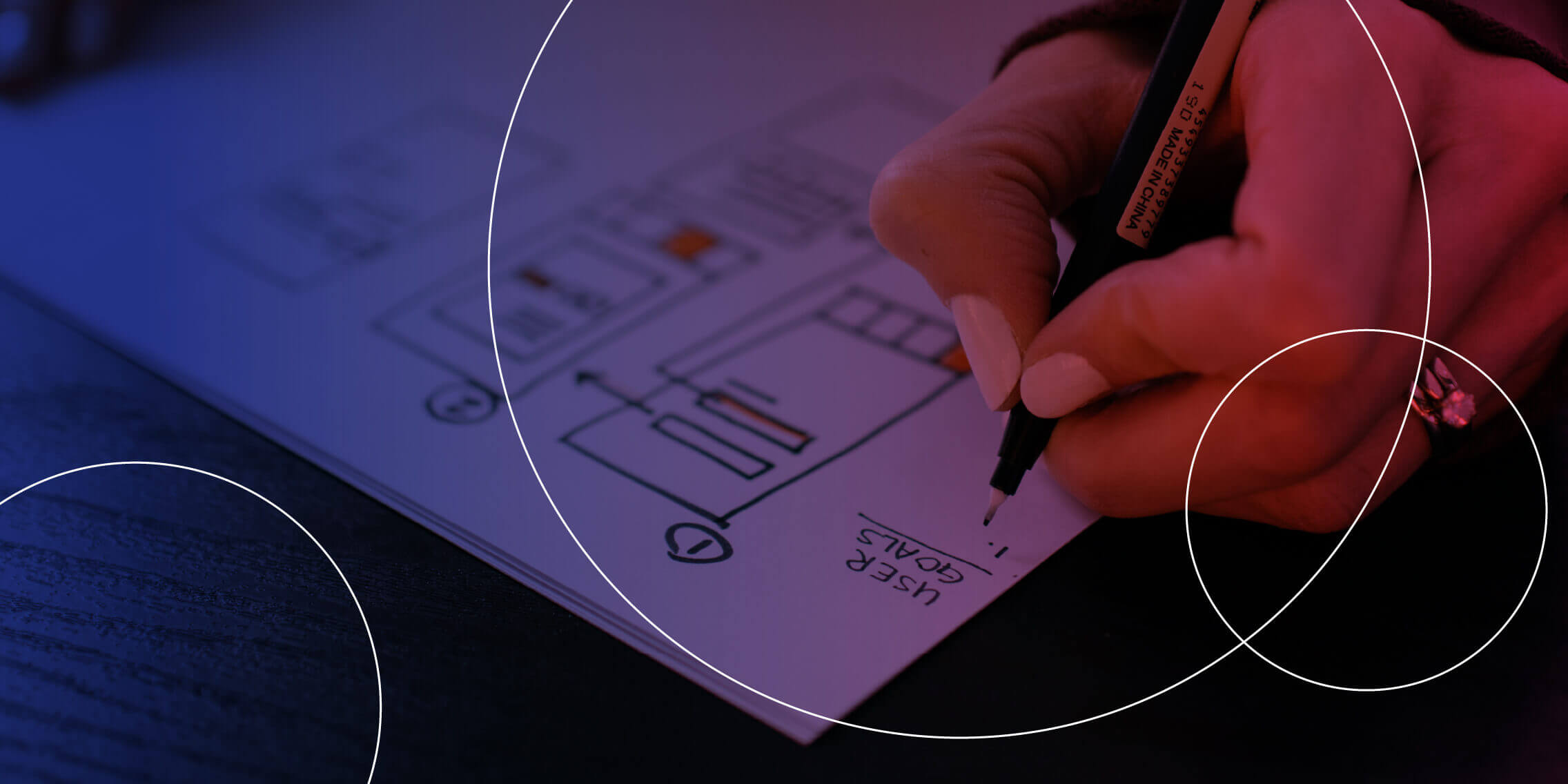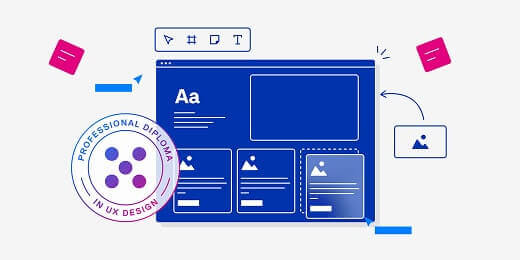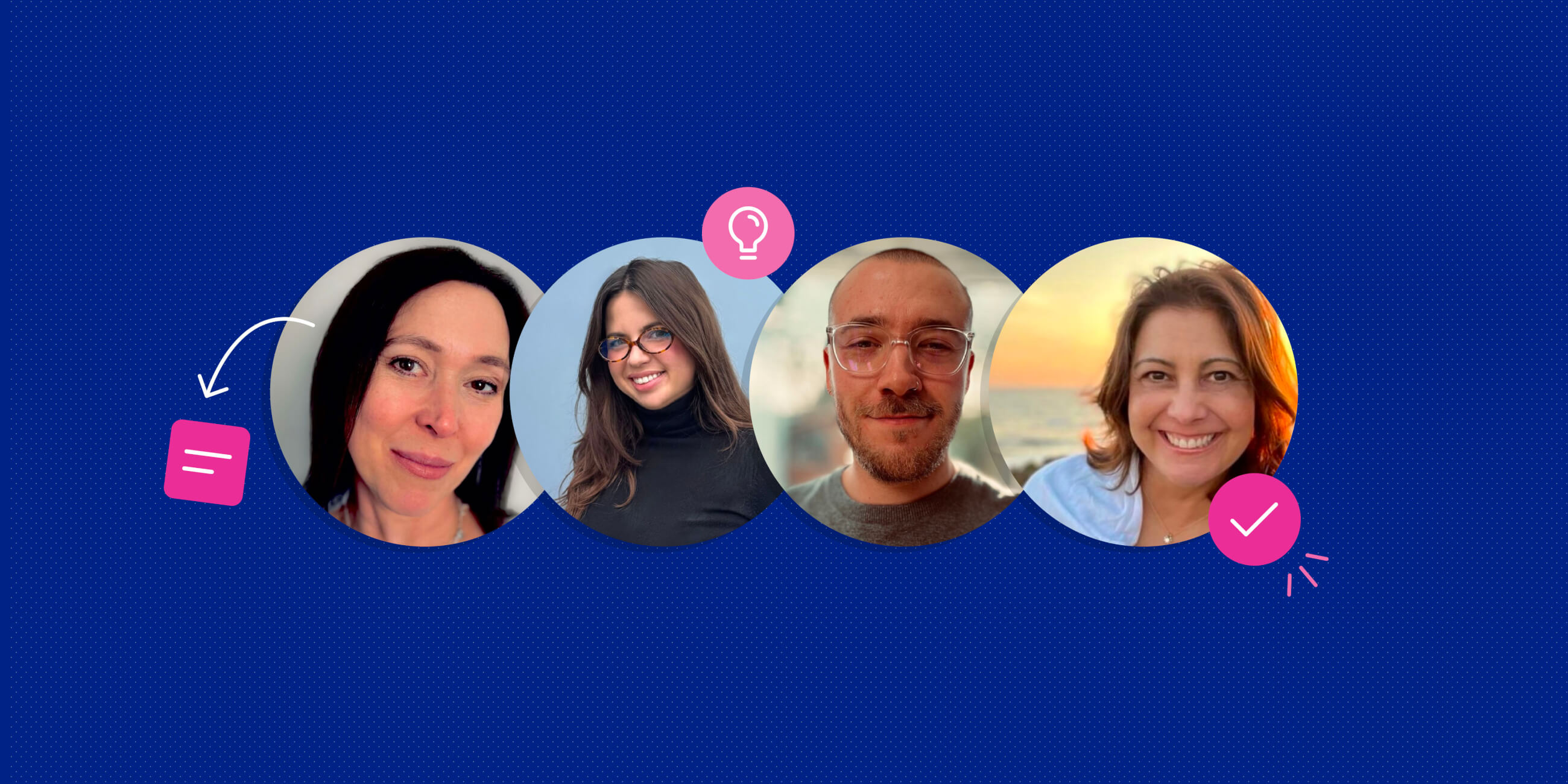It’s one of the biggest challenges new UX designers face: building a UX portfolio before you’ve got any on-the-job experience.
Fortunately, there are opportunities everywhere to apply your UX skills—you don’t need to wait til you’re hired.
In this post, we’ll show you how to find projects for your first UX portfolio.
But before we do that, let’s recap on what your UX portfolio should demonstrate. This will help you when it comes to completing and showcasing your projects.
What goes into your UX portfolio, and what should your portfolio demonstrate?
Your UX portfolio is a website that showcases some of your best UX project work. It should demonstrate 3 main things:
- Key UX hard skills such as user research, wireframing and prototyping
- Your understanding and application of the UX design process
- How you think and problem-solve as a designer
You can learn all about what a UX portfolio is, why it’s important, and what it should include in our complete guide to UX portfolios. But, in a nutshell, your UX portfolio should contain an “About” page, contact details and, most importantly, examples of your work. Your work is presented in the form of case studies.
What is a UX case study?
A UX case study tells the story of a design project you worked on. It outlines your design process from A to Z, detailing the problem you set out to solve, the users you were solving it for, the methods and processes you used, and the final solution.
Case studies include a mixture of text and visuals. As you explain your process, you can illustrate each step with screenshots, photos, videos, wireframes and prototypes, data and quotes.
UX case studies are the heart of your portfolio. They show employers that you’ve got the necessary skills to work as a UX designer. But how are you supposed to create UX case studies if you haven’t yet worked on any UX projects?
Worry not. Here are 5 tried-and-tested ways to gain valuable UX experience and build case studies for your portfolio.
5 Ways to find projects for your UX portfolio without experience
1. Conduct an unsolicited redesign
An unsolicited redesign is where you take an existing product, service or feature and voluntarily redesign it—without being asked to do so. You’re not working on behalf of a company or client, and your solutions won’t be used.
However, you do get to apply your UX design skills to a real product. Excellent material for your portfolio!
How to conduct an unsolicited redesign
To conduct an unsolicited redesign, you first need to identify a UX problem within an existing product.
Think about the apps and websites you use on a regular basis. Are you constantly frustrated with your banking app? Did you recently abandon a full online shopping cart because the checkout process was so cumbersome? Could the task of finding new music on your favourite streaming platform be improved in some way?
Once you start looking for those UX problems, you’ll notice them everywhere. Pick one you fancy tackling and define the scope of the project. This could be “streamlining the checkout process on the ASOS website” or “improving the profile-building feature on the Bumble dating app”.
From there, follow the entire UX process, starting with user research and moving right through to final designs. By the end, you’ll have a fully-fledged project to showcase in your portfolio.
Unsolicited redesign examples
To help you with your own unsolicited redesign, here are some examples of what other designers have done:
- Carolina Niglio’s unsolicited redesign of the PayPal app
- Jeff Shibasaki’s unsolicited redesign of the Colgate website
- Daniel Lopes’ Tinder redesign
- Jason Yuan’s unsolicited redesign of Apple Music
Tips for completing a successful unsolicited redesign
Treat your unsolicited redesign like a real UX project. Don’t be tempted to cut corners; the aim is to apply your skills as practically as possible. Here are some tips to ensure your unsolicited redesign is a success:
- Recruit real people for things like user research and testing. Involve friends and family who are familiar with the product you’re redesigning, or advertise in Facebook groups
- Document everything along the way, ready to be featured in your portfolio case study
- When writing up your case study, clearly state that it’s an unsolicited redesign
- Feature “before” and “after” comparisons to show how your redesign has improved the existing product
Unsolicited redesigns demonstrate exactly how you’d approach a real client project—and they show that you’re a proactive and resourceful designer. A great impression to make in your UX portfolio.

2. Design to fix a real user problem
This is similar to an unsolicited redesign, except the product doesn’t actually exist yet—you’re going to conceptualise and design it from scratch. You might hear this referred to as a fictitious UX project.
The main difference between an unsolicited redesign and the “fictitious project” approach is that you’re starting with an unsolved user problem rather than improving an existing design. The scope for creativity is therefore a lot broader.
How to complete a fictitious UX project
To complete your fictitious UX project, you first need to give yourself a design brief. This means identifying a user problem that doesn’t seem to have an existing solution.
Again, you’ll need to view the world through your UX lens in order to spot those unsolved problems. Perhaps you find yourself in a state of confusion whenever it comes to recycling your household rubbish. Wouldn’t it be great if you had an app that could help you identify the right bin for different types of waste?
Maybe you wish there was an easier way to meet people when you go travelling, or to curate playlists that match the tempo of your movement while you’re working out. Wherever there’s a user problem, there’s a UX design project just waiting to happen!
Once you’ve identified your UX problem, all the usual rules apply. Go through the UX process from start to finish, documenting all your research, early ideations, and final designs.
Tips for an effective fictitious UX project
Fictitious UX projects can be overwhelming as there’s so much room for creativity. Here’s how to make it work:
- Focus on applying the UX design process—not on coming up with the most innovative, groundbreaking idea. It doesn’t matter if there is actually a solution out there somewhere; the most important point is that you’re designing your own solution from scratch
- As with the unsolicited redesign, make it clear that your case study is based on a fictitious UX project
- Share how your own experiences inspired your fictitious project. This makes for interesting reading in your portfolio case study
If you’re struggling to come up with your own design challenge, why not try a design challenge generator? Sites like Sharpen Design, Briefz, and What Should I Design? are great sources of UX inspiration.
3. Volunteer your UX skills for free
There are plenty of organisations out there who could benefit from a UX designer but don’t have the funds to hire one. If you’ve got the time, volunteering is a great way to use your UX skills and gain real-world experience.
Where to find UX volunteering opportunities
One way to find UX volunteering opportunities is through dedicated websites and portals such as:
You can also send out speculative applications. Research local non-profits or large-scale initiatives you’re interested in and familiarise yourself with their work. Then send an email to introduce yourself and the skills you can offer. Be ready to pitch ideas for how you might help them in case they want specifics.
Once you’ve landed a volunteering gig, you should have lots of material for your UX portfolio. As always, document everything you work on so you can turn it into a coherent case study.
UX volunteering case study examples
Volunteering isn’t just for entry-level designers; many senior UXers offer their skills pro-bono as a way of giving back. If you’re curious about how a UX volunteering case study might look, here are some examples:
How to make the most of your UX volunteering gig
Not only is it nice to offer your skills for a good cause—you’ll learn a lot from the experience, too. Here’s how to make the most of your UX volunteering gig:
- If possible, get involved in a cause that you genuinely care about. This will make it easier to talk about your UX work and create an interesting case study
- Ask for a testimonial from the people you work with; this will look great on your portfolio website
You can learn more about how volunteering can help you build your UX portfolio in this guide.
Photo by Jason Goodman on Unsplash
4. Take a UX design course
If you want a structured approach to learning UX design and creating a professional portfolio, consider a UX design course.
Many UX courses include project work in the curriculum, and some will even guide you through the portfolio-building process. Depending on the setup, you may also have access to mentors or industry professionals who can review your project work and give feedback.
Even without all the extras, a UX course with a project-based syllabus provides an excellent starting point for your portfolio. You’ll learn the UX process from start to finish, and can build out your first UX case study as you go.
Choosing a UX design course
There are several factors to consider when choosing a UX design course. Think about the following:
- Do you want to study flexibly online, or attend in-person classes?
- How much time can you dedicate to a UX course?
- What’s your budget?
- Should you choose a university credit-rated UX program?
- How practical is the curriculum?
Do plenty of research before signing up—including taking a look at what UX course graduates have to say about their experience.
UX portfolio examples from course graduates
If you’re wondering how your portfolio might look if you build it as part of a UX course, check out these portfolios created by graduates of the UX Design Institute:
- Veronica Praml’s UX research and design portfolio
- Alexis’ product design portfolio
- Adam Carbeck’s UI/UX portfolio
For more inspiration, take a look at our complete round-up of the best UX graduate portfolio examples (and what we can learn from them).
How to make the most of your UX course project work
If you’re building your UX portfolio based solely on course work, you might have concerns about standing out. Here are some ways to ensure your UX portfolio is unique:
- Create spin-off projects and case studies. The curriculum might limit you to specific project ideas, but there’s nothing to stop you from developing those ideas into something original. If your course has you designing a dating app, why not create another case study exploring new features and improvements?
- Treat your UX portfolio website as another project. Write a personal “About Me” section, get creative with the UI, and go the extra mile to include videos or a blog
- If you have the opportunity, ask your course instructors or fellow students for a testimonial about what kind of designer you are. This will look great on your portfolio homepage
And remember: Hiring managers ultimately want to see that you understand and can apply the UX design process. You don’t need to reinvent the wheel in order to stand out.
Photo by Christina @ wocintechchat.com on Unsplash
5. Consider a UX internship
It’s not a feasible option for everyone, but if you are able to take on an unpaid (or low-paid) short-term gig, consider a UX internship.
A UX internship will have you working in-house on real design projects. Besides the obvious benefit for your UX portfolio, you’ll have the chance to shadow and learn from experienced UX designers—and get your first taste of working on a design team.
Where to find UX internships
Searching for a UX internship is much like searching for a job. You can use both generic job boards and UX-specific sites, including:
As with volunteering, prioritise finding an internship with a company or brand you’re interested in. With that said, it’s important to be flexible—you can start your search with your “top pick” companies, and then cast the net wider later on.
UX internship case studies
The best way to learn about UX internships (and to weigh up if it’s something for you) is to hear from those who have first-hand experience. Here are some UXers who have shared their internship stories:
- What I learned from my UX internship at the Home Depot by Tony Jin (now working at Google)
- My experience as a UX design intern at Shopify by Helga Jiang (now working at Facebook)
Tips for a successful UX internship
Before you take on a UX internship, it’s important to ensure that you’re in line for a truly valuable experience. Here’s how to get the best out of your UX internship:
- Before you start, get together with your future supervisor to establish clear responsibilities and goals. What exactly will you work on while you’re there? What kind of experience can you expect to gain? This will help to avoid a situation where you’re working for free but not actually getting what you want from the experience
- If you have a good rapport with your supervisor or teammates, ask for their feedback on your UX portfolio. Having a senior UXer review your project case study will help to ensure you’re ticking all the boxes
- Reflect on your internship in your portfolio—not just in terms of how you applied the UX process, but also what you learned about cross-team collaboration and the role of UX within a business
As you can see, there are many ways you can build out your portfolio, long before you’ve landed your first UX job. So what’s next? Try some (or all) of the strategies we’ve shared, and follow this practical step-by-step guide on how to build your UX portfolio from scratch.









